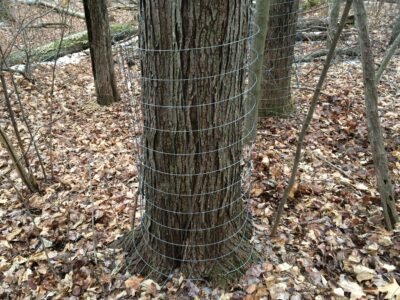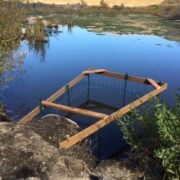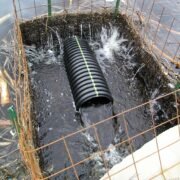
Protect valued specimen trees or large trees that could cause property damage from beaver chewing. When done properly, wrapping trees with heavy wire is 100% effective for years with no maintenance.
Photo © Mike Callahan, Beaver Institute
Why are beavers on my property, and what can I do about it?
Beavers have lived in California for millions of years, but they were almost wiped out by the fur trade. People moved into the bountiful areas beavers had made and had once called home. Today, a recovering beaver population finds itself in conflict over land.
Landowners are in the predicament of incurring possible property damage from flooding or unwanted tree chewing if beavers move onto their property. Oftentimes beavers are killed if conflicts arise, but that practice is more expensive in the long-run because other beavers are likely to move in.
Luckily, there are easy, cost-effective solutions that allow us to live with beavers worry-free and enjoy the benefits they bring to the area. We at the SLO Beaver Brigade are trained in managing beaver conflicts and are here to help you turn any beaver problem into a long-lasting solution.

Photo © Mike Callahan, Beaver Institute
Why live alongside beavers?
Beavers are water bringers. With the challenges we face from drought, wildfires and water shortages, there has never been a more important time to protect and sustain the water on our land.
Beavers do just that by naturally restoring our rivers and streams. By building dams and digging channels, beavers provide themselves with safe habitat and turn degraded streams into lush wetlands.
These healthy wetlands bring huge benefits, such as:
• recharging the groundwater
• lessening the intensity of floods
• creating fire breaks, and
• providing a crucial habitat for wildlife.
Beaver ponds are an oasis of life, and if you’ve never been to a beaver pond in person, we’d love to have you join us on a tour of a mature pond in Atascadero. You can sign up for a Watery Walk to a beaver dam with Audrey and me by sending an email to slobeaverbrigade@gmail.com with the subject line Watery Walk and let us know you want to join us!

Managing beavers with nonlethal water control devices such as this culvert fence is effective for resolving beaver-human conflicts, without losing the ecological and water storage benefits of beavers.
Photo © Mike Callahan, Beaver Institute
Lethal Trapping: Counterproductive and Costly
Lethal trapping of beavers is an outdated and counterproductive practice in California, and it’s the reason our beaver population has remained so low. Beaver trapping is a cruel, short-term solution that has been proven to be more costly and damaging in the long run because, once a beaver is removed from an area, that real estate is up for grabs and another beaver is likely to move in.
In some developed areas, though, it is just not feasible for a beaver cohabitation solution. In this case, it would be beneficial to relocate the beavers to an area that needs them. However, per current California state law, beavers are classified as pests so they cannot be relocated. That means that if a landowner cannot or will not tolerate beavers, they can get a permit to kill them.
Contact the SLO Beaver Brigade for solutions to beaver problems.
The good news is that it doesn’t have to be this way. In other states, such as Washington and Oregon, beavers can be relocated and they have had great success using beavers as restoration tools. Because relocation is not currently legal in California, it is even more important that we understand how to live safely and worry-free with the amazing beaver. There are plenty of relatively low-cost cohabitation methods available, and we at the SLO Beaver Brigade can help.
With tried-and-true beaver management techniques, a landowner can rest assured that their trees and property are safe, whether beavers are currently living there or not.
Beaver solutions that fit your situation.

Flow devices save time and money, protect infrastructure and improve public and work crew safety. Support human land uses while allowing beavers to create valuable wetlands.
Photo © Mike Callahan, Beaver Institute
Beavers are the experts when it comes to stream restoration, but people can mimic beavers, using natural materials to add structure and complexity to incised streams. Depending on the situation, varied structures slow the water flow and catch sediment. Over time, with complexity continually added by beavers, the river bottom builds back up and the stream becomes healthy once again.
You can contact us at slobeaverbrigade@gmail.com to schedule a site assessment and discuss what management methods will work best for you, or you can utilize these free self-help guides provided by the Beaver Institute.